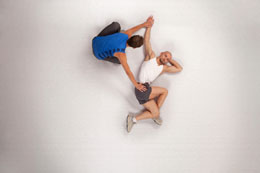The people who are involved in sports, athletics and other physical activities are prone to groin strain. The following article will tell you a few exercises that you can try out to ease your groin strain.

If you are into sports which demand a lot of running on the field, then you might have definitely experienced a groin strain. The groin area is basically comprises the Adductor muscles, these muscles form the inner thighs. The Adductor muscles are composed of Pectineus, Adductor Magnus, Gracilis, Adductor Brevis and Adductor Longus. A groin strain occurs when any of the muscles from the Adductor group are stressed beyond their capacity. There are various exercises that are advised to treat a groin strain. The key to attain relief is to do these exercises correctly. Any of the groin rehabilitation exercises should never aggravate the pain. While doing these exercises, you should feel a gentle pull in the groin region.
Exercises for Groin Strain
A groin strain usually occurs when there is sudden motion of the legs. It can be classified into 3 types, which are distinguished on the basis of the severity of the injury to the Adductors. When few muscle fibers are damaged, then the strain is 'type-1'. If a large number of muscle fibers are injured, then it is 'type-2' strain. An Adductor muscle tear results in a 'type-3' strain. Type-1 strains are characterized by a mild pain while moving your legs, whereas the other types cause higher intensity of pain. Type-1 strains can be readily treated with exercises, but for type-2 and type-3 strains, I recommend you to consult a physician. The following exercises help in the rehabilitation of groin strain:
The Butterfly Stretch
- Sit down and hold your feet with your hand.
- Now, gently pull your feet towards your groin with your hands.
- See that your spine is erect.
- Slowly move your knees towards the ground. You will experience a mild pull at your groin.
- Stay in this position for 20 seconds.
- To increase the intensity of the pull, move your feet closer to your groin.
Adductor Stretch: Sideways
- Stretch your right foot towards the right.
- Make sure that your left foot is pointing forward.
- Now, without changing the position of your left foot, bend your left knee for 20 seconds.
- If you bend your left knee more, the intensity of the pull will increase.
- Now, stretch your left foot towards your left and repeat the procedure by bending your right knee.
Adductor Stretch: Forward
- Move your right foot forward as if you are taking a step.
- Keep the position of your left foot constant, and bend your right knee for 20 seconds.
- Manipulate the intensity of the pull by varying the bend of your knee.
- Repeat, with your left foot forward.
Adductor Stretch: Squat
- Take a squat position.
- Press your elbows to the inner knees, and give outward pressure.
- Be careful that you do not apply too much pressure.
- Maintain this posture for 20 seconds.
Ball Exercises
- Take a ball of the size of a normal soccer ball and lie down.
- Place the ball between your feet and then slowly raise your feet, and then lower it slowly.
- Repeat this exercise 10 times.
- Now, while lying down, rotate your feet. Make sure that ball is held firmly between your feet.
- Rotate slowly and perform 10 rotations.
- After you are done with this, stand up and press the ball against a wall with your right foot. Do this for 15 seconds.
- Repeat the same procedure for your left foot.
Precede your exercise with a warm up and each set of exercise should be repeated thrice. The stretches will relieve the groin strain, whereas the ball exercises will strengthen the Adductor muscles. While doing the butterfly stretch, see that you do not bounce. You can successfully rehabilitate a groin strain by performing these exercises accurately. If you experience intense pain during any of these exercises, stop immediately! Consult a medical practitioner before you start with rehabilitation of any injury, this will help you achieve a better insight about your injury and will prevent its further aggravation.


 If you are into sports which demand a lot of running on the field, then you might have definitely experienced a groin strain. The groin area is basically comprises the Adductor muscles, these muscles form the inner thighs. The Adductor muscles are composed of Pectineus, Adductor Magnus, Gracilis, Adductor Brevis and Adductor Longus. A groin strain occurs when any of the muscles from the Adductor group are stressed beyond their capacity. There are various exercises that are advised to treat a groin strain. The key to attain relief is to do these exercises correctly. Any of the groin rehabilitation exercises should never aggravate the pain. While doing these exercises, you should feel a gentle pull in the groin region.
If you are into sports which demand a lot of running on the field, then you might have definitely experienced a groin strain. The groin area is basically comprises the Adductor muscles, these muscles form the inner thighs. The Adductor muscles are composed of Pectineus, Adductor Magnus, Gracilis, Adductor Brevis and Adductor Longus. A groin strain occurs when any of the muscles from the Adductor group are stressed beyond their capacity. There are various exercises that are advised to treat a groin strain. The key to attain relief is to do these exercises correctly. Any of the groin rehabilitation exercises should never aggravate the pain. While doing these exercises, you should feel a gentle pull in the groin region.